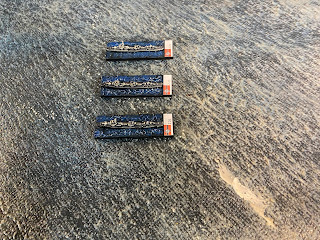I managed to complete the last ship in the IJN a few weeks ago so thought it was time to post a few photos for the sake of posterity. There are sixty-two vessels in this contingent so, rather than drag them out in a series of individual posts I thought I'd deal with them all in one hit, especially as I am still hopeful WWII naval will only be a relatively short segue before I plunge back into my ECW project.
First off, the two giant battleships Yamato and Musashi, with their massive 18" guns that can inflict a lot of damage:
Followed by the Kongo, Nagato, Hiei and Kirishima. Like so many of the Japanese battleships apart from the Yamato class, the Kongo was a pre-WWI design. It was actually designed and built in the United Kingdom, and launched in 1912. The agreement was for the Japanese to take the design and use it as a blueprint for future constructions so it is quite ironical that the British designs were subsequently used against them:
I purchased a set of WWII Japanese naval colours which contains such exotic colours as Sasebo grey, Kure grey and so on, which are all different shades of grey used in the various shipyards after which the colours have been named. I took some time therefore to dig into which ships were constructed in which shipyards and applied the relevant shade of grey. The remaining battleships are the Ise, Hyuga, Fuso and Yamashiro, with the Hyuga post its conversion to a hybrid battleship carrier:
The Japanese heavy cruisers were very good, most being of a relatively modern design and launched in the 1930s. Below are the Tone, Chikuma, Takao, Atago and Chokai:
Followed by the Aobo, Kinugasa, Mogami, Mikuma and Myoko:
With the Ashigara and Kako completing the contingent of heavy cruisers:
By contrast the Japanese light cruisers were of an earlier vintage and generally outclassed by their US Navy counterparts. Below are the Kitakami, Oi (I have always loved that name), Jintsu, Tenryu and Tatsuta:
The Kitakami and Oi were converted into torpedo cruisers and carried forty tubes each, a lot more than the usual six that is found on most other light cruisers, and can therefore wreak havoc if they survive long enough to get close.
Next up are the Katori and Kashima, two training ships which are seriously under-gunned and would struggle against a decent destroyer, alongside the Kuma and Kubari:
With the Agamo, Tama, Nagara and Natori completing the contingent of light cruisers:
Also completed are fifteen destroyers, with the Makinami, Yugumo, Onami, Asashio, Asagumo and Oshio:
The Nenohi, Hatsuharu, Wakaba, Teruzuki, Akuzuki, and Niizuki:
And the Suzutsuki, Wakatsuki and Hatsuzuki. The Japanese destroyers were mostly pretty good and, to be fair, many of the light cruisers were really only intended to act as flagships to flotillas of destroyers.
I also completed a supply ship in the form of the Tatekawa Maru, a fleet oiler:
and four submarines with the I-17, I-19, I-26, and I-29.
These 'B-Class' submarines all carried a Yokosuka E14Y seaplane for spotting purposes, which I have modeled on two of the submarines. As I was painting them I wondered how many unlucky pilots either lost their bearings or returned to the correct spot to find the submarine had submerged and buggered off. The I-17 was actually the first Axis ship to shell mainland United States. It surfaced off California and tried to shell a fuel storage facility but only managed to damage a pier and a pump house. It did however trigger a mass hysteria event which caused the city of Los Angeles to believe it was under aerial attack the following night, resulting in the air defences showering ten tons of shrapnel and unexploded ordnance on the city. Quite understandable given the uncertainty of the times and not dissimilar to episodes elsewhere.
Finally, and well done if you have got this far, I completed seven aircraft carriers. Below are the Taiho, Zuiho and Shoho, the Taiho with its steel-reinforced flight deck and the latter in Midway colours, all courtesy of Flight Deck Decals:
Next the Hiryu and Soryu:
and finally the Kaga and Akagi:
Here are the latter two next to a pencil, just to give an idea of scale:
The planes are very fiddly, not just to paint but to glue in place without ruining the decal on which they are attached. On average I am finding that larger ships such as battleships, carriers and heavy cruisers are taking around three hours each to assemble, base and paint, light cruisers around two hours, and destroyers around fifty minutes to an hour each.
All up then the Japanese fleet is comprised of sixty-two vessels, all of which except the carriers fit nicely into one of my usual storage boxes:





























